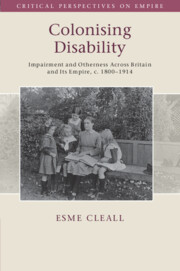Book contents
- Colonising Disability
- Critical Perspectives on Empire
- Colonising Disability
- Copyright page
- Dedication
- Contents
- Tables
- Acknowledgements
- Introduction
- 1 Disability and Otherness in the British Empire
- 2 Saving the Other at Home and Overseas
- 3 ‘A Fearfully and Wonderfully Made Individual’
- 4 Signs of Humanity
- 5 A Deaf Imaginary
- 6 Immigration
- 7 The Health of the Nation
- 8 Conclusion
- Bibliography
- Index
3 - ‘A Fearfully and Wonderfully Made Individual’
Exhibiting Bodily Anomaly
Published online by Cambridge University Press: 21 July 2022
- Colonising Disability
- Critical Perspectives on Empire
- Colonising Disability
- Copyright page
- Dedication
- Contents
- Tables
- Acknowledgements
- Introduction
- 1 Disability and Otherness in the British Empire
- 2 Saving the Other at Home and Overseas
- 3 ‘A Fearfully and Wonderfully Made Individual’
- 4 Signs of Humanity
- 5 A Deaf Imaginary
- 6 Immigration
- 7 The Health of the Nation
- 8 Conclusion
- Bibliography
- Index
Summary
This chapter is about processes of display. Examining the history of ‘freakshows’ I argue that those labelled ‘freaks’ not only constituted part of the population of disabled people, but helped to contribute to the conceptualisation of that category in the public sphere.I argue that the popularity of the freakshow and the prevalence of impairment as a key part of it, attests to the significance of disability as a contemporary social concern. Relatedly, I argue that freakshows contributed to how disability came to be objectified as something ‘other’ and something beyond, if not antithetical to, the self. The chapter is structured around the lives of key performers on the nineteenth-century freakshow circuit: Joseph Merrick (the ‘Elephant Man’); Eng and Chung Bunker (the ‘original Siamese Twins’); Tom Wiggins (‘Blind Tom’); Krao (the ‘Missing Link’); and Maximo and Bartola (‘The Aztec Lilliputians’). It will be noted that all of these performers, except for my first example, Joseph Merrick, were not only disabled or disfigured but were also people of colour and often from colonial sites. This fact, which arises from the sources, tells us something important about the relationship between disability and race in the construction of bodily anomaly.
Keywords
- Type
- Chapter
- Information
- Colonising DisabilityImpairment and Otherness Across Britain and Its Empire, c. 1800–1914, pp. 93 - 122Publisher: Cambridge University PressPrint publication year: 2022



